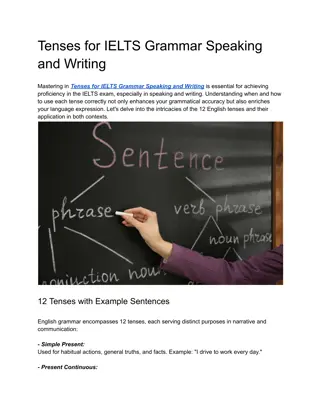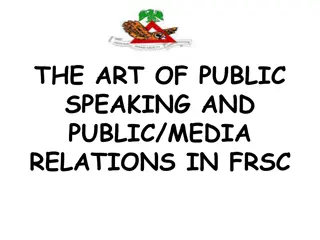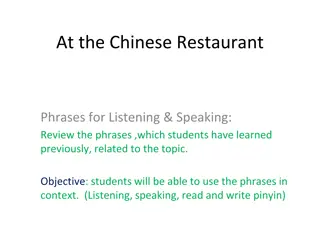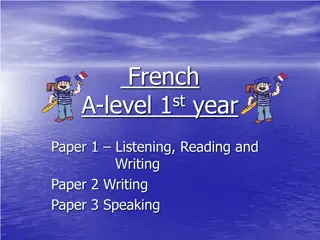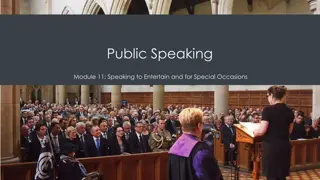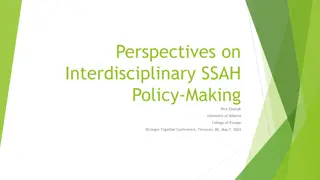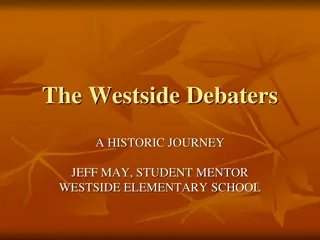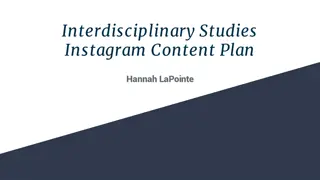Insights into Academic Speaking: Interdisciplinary Perspectives
Explore the differences between spoken academic English and conversational English, examine discipline-specific constraints, and delve into corpus analysis findings that shape EAP materials. Discover the evolution of ESP/EAP traditions, the availability of spoken academic corpora like MICASE, and insights on consistency, frequency, and key words in academic speaking.
Download Presentation

Please find below an Image/Link to download the presentation.
The content on the website is provided AS IS for your information and personal use only. It may not be sold, licensed, or shared on other websites without obtaining consent from the author.If you encounter any issues during the download, it is possible that the publisher has removed the file from their server.
You are allowed to download the files provided on this website for personal or commercial use, subject to the condition that they are used lawfully. All files are the property of their respective owners.
The content on the website is provided AS IS for your information and personal use only. It may not be sold, licensed, or shared on other websites without obtaining consent from the author.
E N D
Presentation Transcript
The vocabulary of academic speaking: an interdisciplinary perspective Michael McCarthy
OUTLINE OUTLINE Is spoken academic English like or unlike conversational English? Are there discipline-specific constraints? Insights from corpus analysis How might these influence EAP materials?
CORPUS EVIDENCE CORPUS EVIDENCE ESP/EAP tradition began with the close analysis of written texts, with limited research on lectures First spoken corpora, like written, tended to survey the language as a whole Development towards smaller, targeted spoken corpora (e.g. workplace, media, EAP) Now several good spoken academic corpora available (e.g. MICASE BASE), plus major publishers corpora
SOME SUB SOME SUB- -CORPORA OF MICASE CORPORA OF MICASE Biology Engineering Arts & Humanities Each approx. 190k words
CONSISTENCY CONSISTENCY How much do the sub-corpora share with the whole corpus? How much do the sub-corpora compare with non-academic speaking?
MICASE: consistency 0.60 0.50 0.40 0.30 0.20 0.10 0.00 all all all engineering biology arts & hum
Consistency: MICASE sub-corpora vs social conversation 0.45 0.4 0.35 0.3 0.25 0.2 0.15 0.1 0.05 0 soc conv soc conv soc conv enginerring biology arts & hum
FREQUENCY AND KEY WORDS Frequency: raw totals of occurrences Key words: words occurring (or not occurring) with statistical significance
HIGH-FREQUENCY ITEMS IN ACADEMIC SPEAKING MICASE & BASE: Frequency: (in top 100) items associated with conversation, informality and interactive contexts: you, I, like hesitation markers (um, uh) discourse/pragmatic markers and/or response tokens (right, well, think, know, actually, okay)
FREQUENCY VERSUS KEY WORDS: ACADEMIC SPEAKING VS. SOCIAL CONVERSATION frequency key word I X you X er X well X erm X right mm okay know X
know in MICASE 39% 61% you know other In conversation, 66% of know = you know
SOME EXAMPLES FROM TOP 100 KEY WORDS: MICASE & BASE point terms sense
SOME EXAMPLES FROM TOP 100 KEY WORDS: MICASE & BASE point terms sense
Point in MICASE 421 437 Physical Sciences and Engineering Humanities
Point across interaction types 200 180 160 140 120 100 80 60 40 20 0 Highly interactive Highly monologic Mostly interactive Mostly monologic Mixed physical sciences arts & hum
SOME EXAMPLES FROM TOP 100 KEY WORDS: MICASE & BASE point terms sense
In terms of BASE Soc conv 0 50 100 150 200 250 300 350 400 450 500
In terms of ... (MICASE) 160 140 120 100 80 60 40 20 0 Social Sciences and Education Humanities Biological and Health Sciences Physical Sciences and Engineering
SOME EXAMPLES FROM TOP 100 KEY WORDS: MICASE & BASE point terms sense
SENSE (MICASE) N Cluster 1 IN THE SENSE THAT 2 A SENSE IN WHICH 3 SO IN A SENSE 4 DOES THAT MAKE SENSE
Does that make sense? (MICASE) PHYSICAL SCIENCES AND ENGINEERING BIOLOGICAL AND HEALTH SCIENCES SOCIAL SCIENCES AND EDUCATION HUMANITIES 0 2 4 6 8 10 12 14 16 18 20
CONSISTENCY: A FURTHER EXAMPLE Distribution of pronouns is a key to stylistic differences
CONSISTENCY Shift in relative values of I and you I and you: consistency in Soc conv & BASE 0 CONV 1 1 2 3 CONV 4 4 5 6 7 BASE 8 8 9 10 BASE 11 11 12 I you
VARIATION ACROSS EVENTS: USE OF I I in academic speech events (per 10k wds) 1-1 lit sup, 314 350 med lec A, 283 300 guest sp inf, 247 250 200 150 100 med lec B, 10 50 0 1-1 lit sup guest sp inf med lec A med lec B
CONCLUSION Academic speaking shares much in common with conversation (lexis, grammar, pragmatic marking) No one prescribed or proscribed style: distribution of interactive vocabulary has discipline-specific implications Institutional labels (lecture, seminar, tutorial) not an infallible guide to degree of conversational features Different tools (frequency, key words, chunks, consistency) all add to nuanced picture EAP and academically/vocationally oriented materials can directly teach the lexico-grammar of academic speaking Learners need to be prepared for a wide range of possible styles
THANK YOU FOR THANK YOU FOR LISTENING LISTENING






